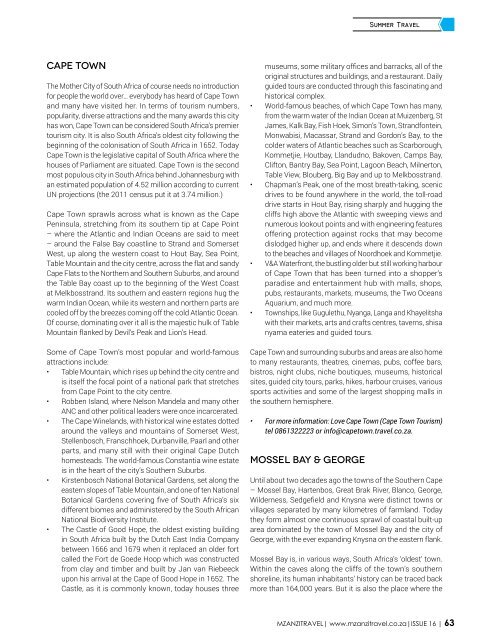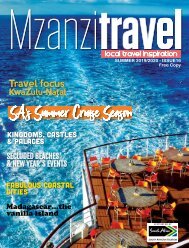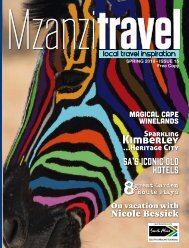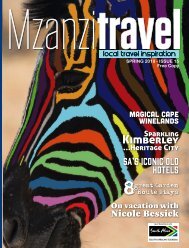MZANZI ISSUE 16
Create successful ePaper yourself
Turn your PDF publications into a flip-book with our unique Google optimized e-Paper software.
Summer Travel<br />
Cape Town<br />
The Mother City of South Africa of course needs no introduction<br />
for people the world over… everybody has heard of Cape Town<br />
and many have visited her. In terms of tourism numbers,<br />
popularity, diverse attractions and the many awards this city<br />
has won, Cape Town can be considered South Africa’s premier<br />
tourism city. It is also South Africa’s oldest city following the<br />
beginning of the colonisation of South Africa in <strong>16</strong>52. Today<br />
Cape Town is the legislative capital of South Africa where the<br />
houses of Parliament are situated. Cape Town is the second<br />
most populous city in South Africa behind Johannesburg with<br />
an estimated population of 4.52 million according to current<br />
UN projections (the 2011 census put it at 3.74 million.)<br />
Cape Town sprawls across what is known as the Cape<br />
Peninsula, stretching from its southern tip at Cape Point<br />
– where the Atlantic and Indian Oceans are said to meet<br />
– around the False Bay coastline to Strand and Somerset<br />
West, up along the western coast to Hout Bay, Sea Point,<br />
Table Mountain and the city centre, across the flat and sandy<br />
Cape Flats to the Northern and Southern Suburbs, and around<br />
the Table Bay coast up to the beginning of the West Coast<br />
at Melkbosstrand. Its southern and eastern regions hug the<br />
warm Indian Ocean, while its western and northern parts are<br />
cooled off by the breezes coming off the cold Atlantic Ocean.<br />
Of course, dominating over it all is the majestic hulk of Table<br />
Mountain flanked by Devil’s Peak and Lion’s Head.<br />
Some of Cape Town’s most popular and world-famous<br />
attractions include:<br />
• Table Mountain, which rises up behind the city centre and<br />
is itself the focal point of a national park that stretches<br />
from Cape Point to the city centre.<br />
• Robben Island, where Nelson Mandela and many other<br />
ANC and other political leaders were once incarcerated.<br />
• The Cape Winelands, with historical wine estates dotted<br />
around the valleys and mountains of Somerset West,<br />
Stellenbosch, Franschhoek, Durbanville, Paarl and other<br />
parts, and many still with their original Cape Dutch<br />
homesteads. The world-famous Constantia wine estate<br />
is in the heart of the city’s Southern Suburbs.<br />
• Kirstenbosch National Botanical Gardens, set along the<br />
eastern slopes of Table Mountain, and one of ten National<br />
Botanical Gardens covering five of South Africa’s six<br />
different biomes and administered by the South African<br />
National Biodiversity Institute.<br />
• The Castle of Good Hope, the oldest existing building<br />
in South Africa built by the Dutch East India Company<br />
between <strong>16</strong>66 and <strong>16</strong>79 when it replaced an older fort<br />
called the Fort de Goede Hoop which was constructed<br />
from clay and timber and built by Jan van Riebeeck<br />
upon his arrival at the Cape of Good Hope in <strong>16</strong>52. The<br />
Castle, as it is commonly known, today houses three<br />
museums, some military offices and barracks, all of the<br />
original structures and buildings, and a restaurant. Daily<br />
guided tours are conducted through this fascinating and<br />
historical complex.<br />
• World-famous beaches, of which Cape Town has many,<br />
from the warm water of the Indian Ocean at Muizenberg, St<br />
James, Kalk Bay, Fish Hoek, Simon’s Town, Strandfontein,<br />
Monwabisi, Macassar, Strand and Gordon’s Bay, to the<br />
colder waters of Atlantic beaches such as Scarborough,<br />
Kommetjie, Houtbay, Llandudno, Bakoven, Camps Bay,<br />
Clifton, Bantry Bay, Sea Point, Lagoon Beach, Milnerton,<br />
Table View, Blouberg, Big Bay and up to Melkbosstrand.<br />
• Chapman’s Peak, one of the most breath-taking, scenic<br />
drives to be found anywhere in the world, the toll-road<br />
drive starts in Hout Bay, rising sharply and hugging the<br />
cliffs high above the Atlantic with sweeping views and<br />
numerous lookout points and with engineering features<br />
offering protection against rocks that may become<br />
dislodged higher up, and ends where it descends down<br />
to the beaches and villages of Noordhoek and Kommetjie.<br />
• V&A Waterfront, the bustling older but still working harbour<br />
of Cape Town that has been turned into a shopper’s<br />
paradise and entertainment hub with malls, shops,<br />
pubs, restaurants, markets, museums, the Two Oceans<br />
Aquarium, and much more.<br />
• Townships, like Gugulethu, Nyanga, Langa and Khayelitsha<br />
with their markets, arts and crafts centres, taverns, shisa<br />
nyama eateries and guided tours.<br />
Cape Town and surrounding suburbs and areas are also home<br />
to many restaurants, theatres, cinemas, pubs, coffee bars,<br />
bistros, night clubs, niche boutiques, museums, historical<br />
sites, guided city tours, parks, hikes, harbour cruises, various<br />
sports activities and some of the largest shopping malls in<br />
the southern hemisphere.<br />
• For more information: Love Cape Town (Cape Town Tourism)<br />
tel 0861322223 or info@capetown.travel.co.za.<br />
Mossel Bay & George<br />
Until about two decades ago the towns of the Southern Cape<br />
– Mossel Bay, Hartenbos, Great Brak River, Blanco, George,<br />
Wilderness, Sedgefield and Knysna were distinct towns or<br />
villages separated by many kilometres of farmland. Today<br />
they form almost one continuous sprawl of coastal built-up<br />
area dominated by the town of Mossel Bay and the city of<br />
George, with the ever expanding Knysna on the eastern flank.<br />
Mossel Bay is, in various ways, South Africa’s ‘oldest’ town.<br />
Within the caves along the cliffs of the town’s southern<br />
shoreline, its human inhabitants’ history can be traced back<br />
more than <strong>16</strong>4,000 years. But it is also the place where the<br />
<strong>MZANZI</strong>TRAVEL| www.mzanzitravel.co.za|<strong>ISSUE</strong> <strong>16</strong> | 63
















